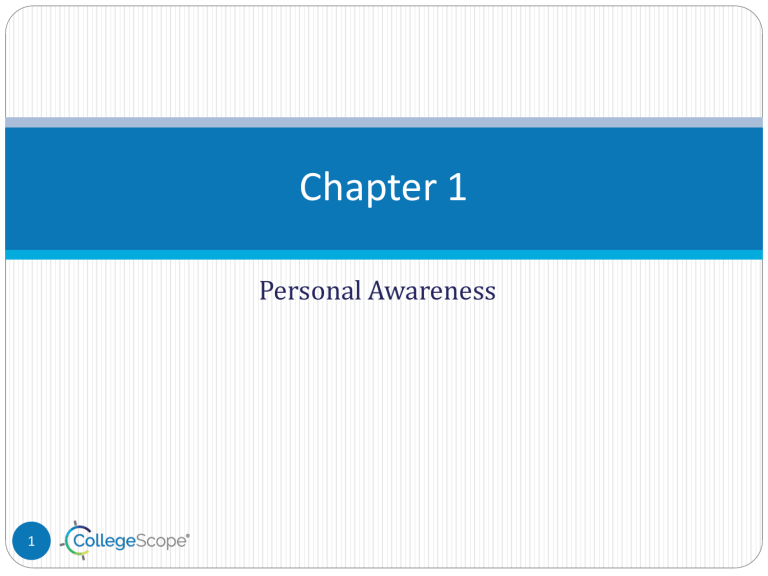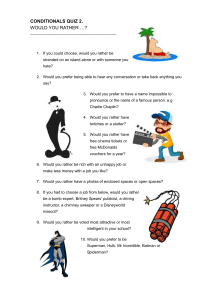
Chapter 1 Personal Awareness 1 Motivation Video Success Stories 2 Chapter 1: Personal Awareness In This Chapter You Will: Assess your: 3 motivation, values, personality, interests, and multiple intelligences. Chapter 1: Personal Awareness Some Common Motivators Family Money Goals Values Fear of consequences Other motivators? 4 Chapter 1: Personal Awareness Internal Motivation These are motivators we create for ourselves. For example: Students who were internally motivated to get out of bed this morning would respond… “To get a good education” “To advance in my job” “To accomplish my goals” 5 Chapter 1: Personal Awareness External Motivation External motivations are created for us. For example: Students who were externally motivated to get out of bed may respond... “My mom made me” “I have to attend school or I have to get a full-time job” “Financial aid requires me to get good grades” “To make my family proud” 6 Chapter 1: Personal Awareness Which Do You Think Is a Better Indicator of Success? Internal or External Motivation? Internal Motivation 7 Chapter 1: Personal Awareness Another Perspective? External motivation requires an audience. If you remove the praise, rewards or attention, would you still be doing what you are doing? If the answer is No, then you are not doing what you love! 8 Chapter 1: Personal Awareness Values Success depends on doing something you love that is important to you – also known as doing what you value. What do you value? How does it relate to your career and professional goals? 9 Chapter 1: Personal Awareness Values Activity Take a moment to list your top 10 goals for the next 10 15 years! Dream big! Write each goal on a separate sheet of paper and place in front of you. Ready? Now throw away 2 of your goals Now another 2…. 1 more!!! What goals are you left with?? These goals are most important to you…these are your VALUES!! Chapter 1: Personal Awareness Let’s Discuss... How did it feel to throw away your values during this activity? Can you think of a time in your life when you were asked to throw your values away? How did it feel? Make sure your career and life goals honor your values!!! 11 Chapter 1: Personal Awareness Homework Chapter 1 Slides 6-9: Assessing and Identifying your Values Use O*NET online to: Match your top work values with careers. 2. Match your top interests with careers. 3. Explore careers by title, industry cluster, outlook, or school subject. 1. 12 Chapter 1: Personal Awareness Getting to Know O*NET 13 Chapter 1: Personal Awareness Personality Personality refers to our natural behaviors – how we understand and interact with the world around us. -Carl Jung AchieveWORKS Personality® is based on the MyersBriggs Type Indicator ® (MBTI ®). According to Jung, we are all born with a certain “personality”. The way we express our natural behavior may appear different depending on our different stages and phases of life, but our true personality never changes. 14 Chapter 1: Personal Awareness The AchieveWORKS Personality Overview Extravert Sensing Thinking Judging 15 Chapter 1: Personal Awareness Introvert Intuitive Feeling Perceiving Where Does YOUR Energy Come From? Extraverts’ energy comes from others. Known for thinking out loud, extraverts have a very large group of friends. They live out loud! We always know when an extravert is having a bad day, good day, fighting with a friend, dating new, etc. Introverts’ energy comes from within. They prefer time to think before they speak and have a small inner circle of friends. Introverts during conflict will disappear and work it out on their own before sharing with others. 16 Chapter 1: Personal Awareness How Do YOU Make Sense of Your Environment? Sensors use what’s right in front of them. They are very good at social cues, depend heavily on their senses, and enjoy being experts. The more information they have, the better! Intuitives are the most creative! They take what’s in front of them and change it into something you have never seen before. They are often so busy being creative that they do not notice social cues. 17 Chapter 1: Personal Awareness How Do YOU Make Your Decisions? Thinkers prefer to make decisions based on logic and rules. They enjoy a good argument or debate, and often appear disconnected or unaffected by emotions. Feelers prefer to make decisions based on their value system. They often put other people’s needs ahead of their own, dislike conflict, prefer harmony. 18 Chapter 1: Personal Awareness How Do YOU Organize Your Environment? Judgers need organization in their life. They must have a plan A, B, and C in place to feel confident, dislike change, and are at their best when using some sort of calendar or to do list. Perceivers prefer change. They are very adaptable, perform best in an unstructured environment, and will become frustrated if structure is imposed. 19 Chapter 1: Personal Awareness What Were Your AchieveWORKS Personality Results? Is your tested type and guessed type the same? If not, ask … how do you prefer to be in a work environment? 20 Chapter 1: Personal Awareness Another Perspective on Type Keirsey: When the types interact they create certain temperaments. Each temperament has its own unique qualities, strengths and challenges. Guardians Artisans Idealists Rationals (ESTJ, ISTJ, ESFJ, ISFJ) (ENFJ, INFJ, ENFP, INFP) 21 Chapter 1: Personal Awareness (ESTP, ISTP, ESFP, ISFP) (ENTJ, INTJ, ENTP, INTP) Guardians ESTJ, ISTJ, ESFJ, ISFJ Organized, comfortable with rules, responsible As children, they followed rules in class and respected authority figures Important for them to always have harmony in life 22 Chapter 1: Personal Awareness Guardians ESTJ, ISTJ, ESFJ, ISFJ Rebel during adolescence, but usually not for long Dislike new experiences. May make decisions quickly, then be unwilling to change – even if change is for the better Change in their schedule may cause panic Take themselves and life very seriously 23 Chapter 1: Personal Awareness Artisans ESTP, ISTP, ESFP, ISFP Adaptable to change Prefer hands-on activities, highly impulsive Graceful and skillful As children, these were the risk takers or daredevils 24 Chapter 1: Personal Awareness Artisans ESTP, ISTP, ESFP, ISFP Curious, playful Find themselves in trouble a lot Rooms and living areas are often in a disarray Often late or unprepared Need to be constantly talking and moving 25 Chapter 1: Personal Awareness Idealists ENFJ, INFJ, ENFP, INFP Value relationships above all else Even as children, were on a search for meaning in their lives Tend to take things personally. May seem too serious about understanding meaning in things as opposed to enjoying them 26 Chapter 1: Personal Awareness Idealists ENFJ, INFJ, ENFP, INFP May be accused of being “ too emotional” Usually loving and affectionate, but can rage and hold grudges for long periods of time Communicating effectively is an important drive for them Naturally drawn to the arts or activities which allow for creativity 27 Chapter 1: Personal Awareness Rationals ENTJ, INTJ, ENTP, INTP Problem solvers and original thinkers Independent, stubborn, can seem defiant Place high value on competence As children they were constantly questioning “I know better than anyone else” More interested in learning than pleasing others 28 Chapter 1: Personal Awareness Rationals ENTJ, INTJ, ENTP, INTP Set incredibly high standards for themselves Get bored very quickly, need to continue to learn to stay engaged Change interests and hobbies as they master them “Emotionally unattached”, may reject physical contact from others 29 Chapter 1: Personal Awareness Multiple Intelligences (Abilities) Are a result of natural talents and the degree to which we develop them Different abilities can be used to accomplish the same goal Multiple intelligences (abilities) are defined as what can be done well 30 Chapter 1: Personal Awareness Multiple Intelligences 31 Linguistic Musical Spatial Kinesthetic Strong verbal skills Natural rhythm, pitch and melody Shapes, visual patterns and distance Strong in movement and coordination Chapter 1: Personal Awareness Multiple Intelligences 32 Intrapersonal Interpersonal Naturalist Mathematical Existential Understanding self and strengths People, relationships, and “Green thumb” Reasoning, sequences and patterns How different ideas connect into a broader concept communication Chapter 1: Personal Awareness Interests What you enjoy doing John Holland: Holland’s Interest Code (RIASEC) Often interests are inter-related Created hexagon to explain interests 33 Chapter 1: Personal Awareness Holland’s Hexagon Realistic Investigative Conventional Enterprising 34 Chapter 1: Personal Awareness Artistic Social Holland’s Interests Realistic 35 • Doers, they prefer being outdoors, using tools, operating machines, interacting with animals, working with their hands. Investigative • Intellectuals, prefer scientific, scholarly exploration and discovery. They like to solve problems and perform experiments. Artistic • Creative, prefer working with ideas that are visual and verbal. Excel in dance, music, art, drawing, painting, design and drama. Chapter 1: Personal Awareness Holland’s Interests 36 Social • Helpers, prefer tasks that involve socializing, helping others, teaching, and relationships. Enterprising • Persuaders, prefer tasks that involve leadership, business, debate, entrepreneurship. Conventional • Organizers, prefer practical tasks, structured environments, following the rules and traditional office settings. Chapter 1: Personal Awareness Searching Interests on O*NET 37 Chapter 1: Personal Awareness Searching Interests on O*NET 38 Chapter 1: Personal Awareness What Is Self-Efficacy? Self-efficacy is the degree to which you believe you can perform an action or behavior. It is similar to confidence. However, confidence is just a general belief in yourself, while self-efficacy is the belief that you can do what it takes to complete certain tasks and goals. 39 Chapter 1: Personal Awareness Self-Efficacy Video How to Build Your Creative Confidence 40 Chapter 1: Personal Awareness Developing Self-Efficacy Task Splitting Mentor or Model Feedback and Reinforcement Mood and Attitude 41 Chapter 1: Personal Awareness Chapter Summary Deep personal awareness involves knowing your values, personality, interests, abilities and selfefficacy. Increasing your personal awareness helps you find and achieve purpose. Having and following your purpose brings success. 42 Chapter 1: Personal Awareness


